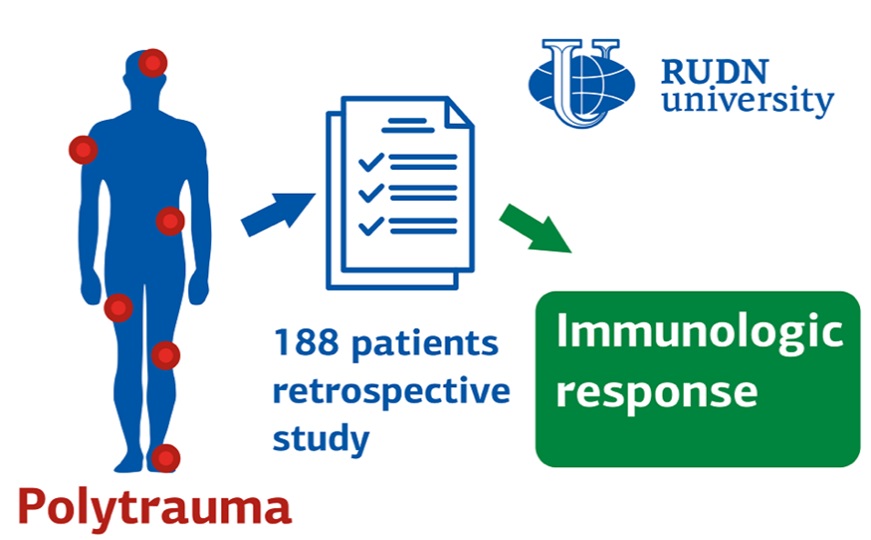RUDN neurosurgeons studied the immune response to multiple injuries

Polytrauma is multiple traumatic injuries of organs and tissues, for example, in car accidents or falls from a great height. Multiple lesions provoke a complex and dynamic immune response of the body. Often, against this background, a patient with polytrauma may develop infectious complications. Therefore, in the treatment of polytrauma, it is necessary to understand the features of the immune response to be able to take action in time.
“Polytrauma requires surgical treatment and intensive care in specialized multidisciplinary trauma centers. It is in this group of victims that the highest mortality and disability are observed. The pathophysiology and immunological aspects of polytrauma are systematically studied. However, the features of defense reactions in traumatic injuries have yet to be studied,” said Albert Sufianov, MD, Educational and Scientific Institute of Neurosurgery, RUDN University.
The medical study involved 188 patients with serious injuries. The control group included 210 trauma patients with minor injuries. Neurosurgeons examined blood samples before hospitalization, during hospitalization, every other day, three days, a week, and then every few days up to three months after hospitalization. Doctors tracked the level of T-lymphocytes — cells that recognize and destroy foreign antigens. The authors also looked at the level of some proteins associated with the immune response — cytokines, chemokines, immunoglobulins and circulating immune complexes.
Under the influence of polytrauma, the content of T-lymphocytes decreased. However, the content of other types of lymphocytes increased. The most pronounced effect became noticeable on the 30th day after discharge. Cytokine concentrations were highest on the day of injury and then gradually declined.
“As we continue to expand our knowledge of the immune response factors associated with polytrauma, we will be better prepared to develop new therapeutic strategies to treat this serious clinical and social problem,” said Albert Sufianov, MD, Director of Educational and Scientific Institute of Neurosurgery, RUDN University.
The results are published in Non-coding RNA Research.
RUDN summarized the results of the scientific competition "Project Start: work of the science club ". Students of the Faculty of Physics, Mathematics and Natural Sciences have created a project for a managed queuing system using a neural network to redistribute resources between 5G segments. How to increase flexibility, make the network fast and inexpensive and reach more users — tell Gebrial Ibram Esam Zekri ("Fundamental Computer Science and Information Technology", Master's degree, II course) and Ksenia Leontieva ("Applied Mathematics and Computer Science", Master's degree, I course).
The National Demographic Report, 2023 Demographic Well-Being of Russian Regions (hereinafter - the National Demographic Report) was prepared by the scientific team of the Institute of Demographic Studies of the Federal Research Center of the Russian Academy of Sciences, the Vologda Scientific Center of the Russian Academy of Sciences, Peoples' Friendship University of Russia, the Center for Family and Demography of the Academy of Sciences of the Republic of Tatarstan, as well as with the participation of leading scientists from the Republic of Bashkortostan, Stavropol Krai, Volgograd, Ivanovo, Kaliningrad, Nizhny Novgorod, Sverdlovsk Oblasts and Khanty-Mansi Autonomous Okrug–Yugra.
RUDN summarized the results of the scientific competition "Project Start: work of the science club ". Students of the Faculty of Physics, Mathematics and Natural Sciences have created a project for a managed queuing system using a neural network to redistribute resources between 5G segments. How to increase flexibility, make the network fast and inexpensive and reach more users — tell Gebrial Ibram Esam Zekri ("Fundamental Computer Science and Information Technology", Master's degree, II course) and Ksenia Leontieva ("Applied Mathematics and Computer Science", Master's degree, I course).
What is your first association with the word “laboratory”? Flasks and beakers? Microscopes and centrifuges? Yes, many of us would answer the same way.
The National Demographic Report, 2023 Demographic Well-Being of Russian Regions (hereinafter - the National Demographic Report) was prepared by the scientific team of the Institute of Demographic Studies of the Federal Research Center of the Russian Academy of Sciences, the Vologda Scientific Center of the Russian Academy of Sciences, Peoples' Friendship University of Russia, the Center for Family and Demography of the Academy of Sciences of the Republic of Tatarstan, as well as with the participation of leading scientists from the Republic of Bashkortostan, Stavropol Krai, Volgograd, Ivanovo, Kaliningrad, Nizhny Novgorod, Sverdlovsk Oblasts and Khanty-Mansi Autonomous Okrug–Yugra.